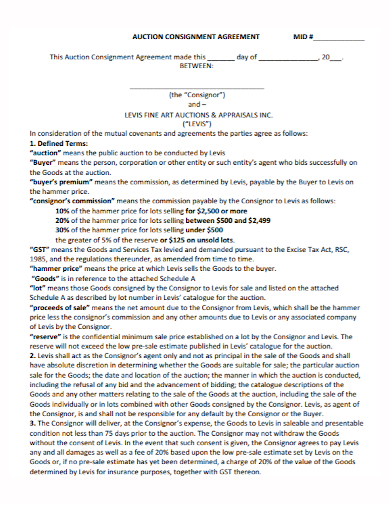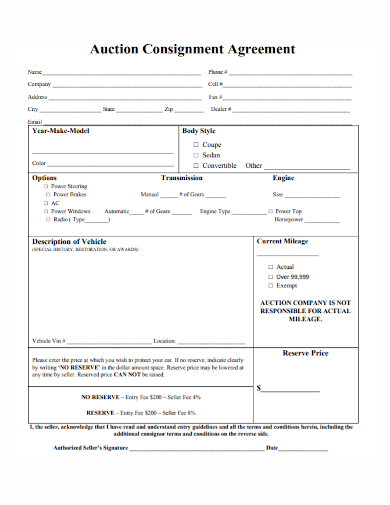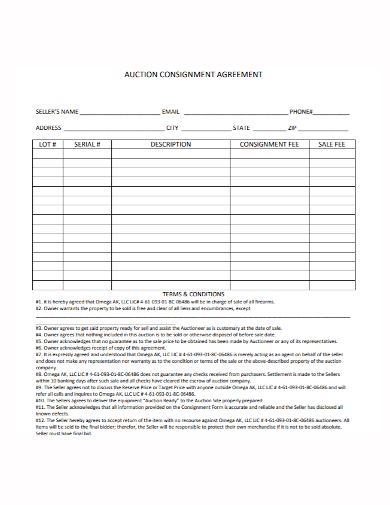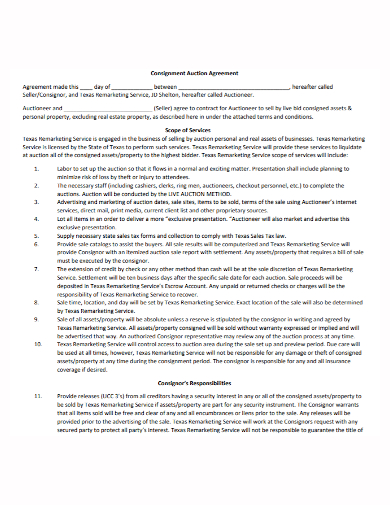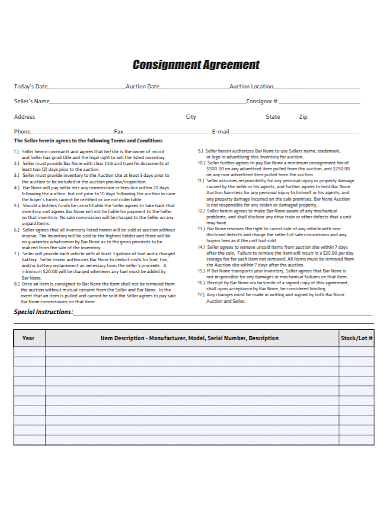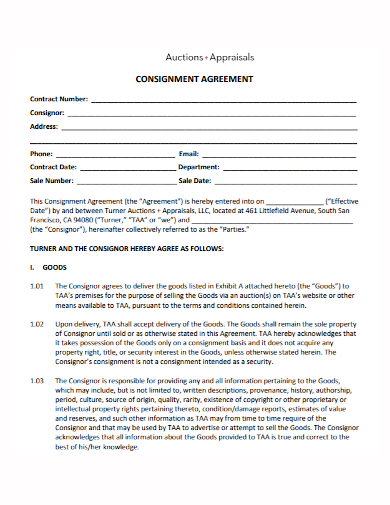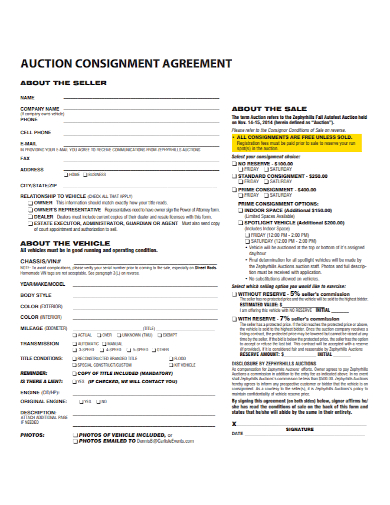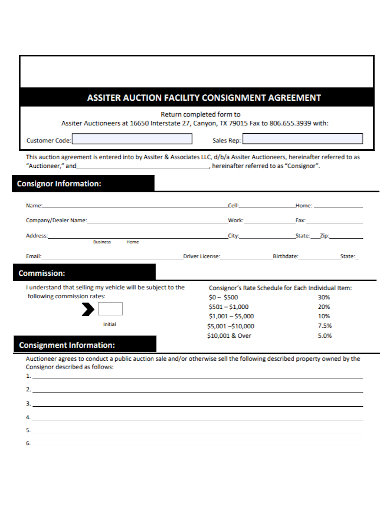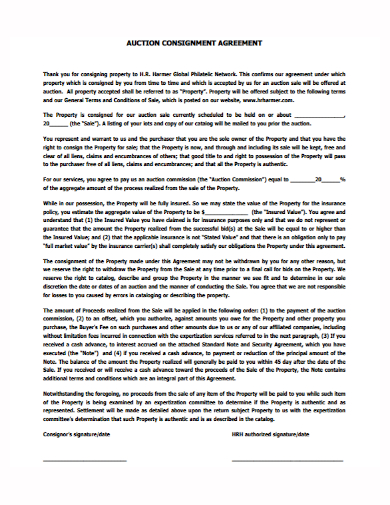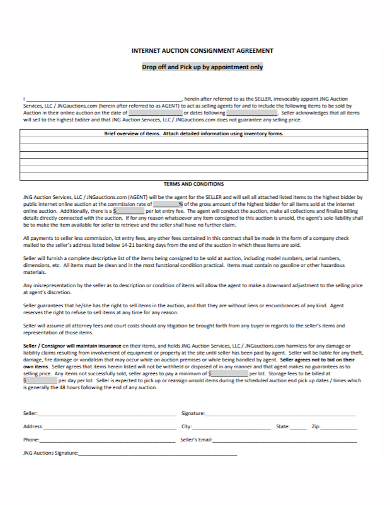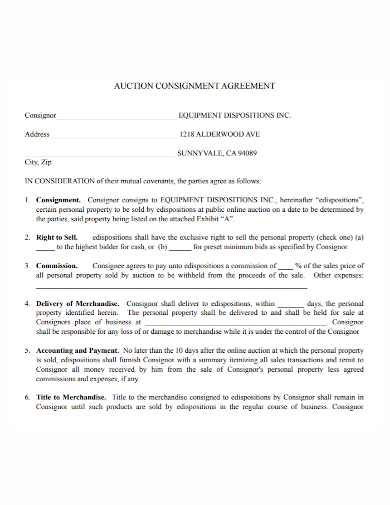The consignment process allows non-profits to work with an outside company that specializes in unique items, trip packages, or experiences, and offer these auction items with no risk because the non-profit only pays for what sells. Event tickets, travel packages, sports memorabilia, art, and even vehicles are common consignment items (motorcycles, cars, etc). Before an auction item can be awarded to a bidder, the Nonprofit must usually meet a set reserve price. This ensures that the consignment company is compensated and that funds are raised to support the organization’s mission.
10+ Auction Consignment Agreement Samples
Consignment is defined as the act of delivering or consigning something. It can also refer to an agreement to pay a supplier or seller after a product is sold. In business jargon, this simply means that someone gives their item to a trusted third party to sell. In exchange for assisting you, the consignor, in selling the item, the third party, or consignee, receives a portion of the proceeds.
1. Auction Consignment Agreement
2. Company Auction Consignment Agreement
3. Seller Auction Consignment Agreement
4. Consignment Auction Agreement
5. Sample Auction Consignment Agreement
6. Auction Consignment Contract Agreement
7. Vehicle Auction Consignment Agreement
8. Auction Facility Consignment Agreement
9. Standard Auction Consignment Agreement
10. Internal Auction Consignment Agreement
11. Auction Equipment Consignment Agreement
Consigning an Auction
- Contact a specialist with a list of items – In a consignment proposal, there are several types of information to include: Close-ups of important details are included in the photograph of the work, Artist/Author, Subject/Title, Date, Publication Location, Dimensions, Signatures, inscriptions, and edition numbers are all included, Descriptions of binding or mount, Condition, and Provenance & acquisition history.
- Consult with the specialist – Consult the specialist about costs, reserves, and other fees. Throughout the consignment process, feel free to ask questions. Estimates are a value range based on auction prices for similar items, dealer prices, and the specialist’s current market knowledge. Estimates are published in the catalog, along with a description of the item, as a guide for potential buyers. A reserve price is a minimum price that has been agreed upon in advance. Our house reserve is half of the low estimate, but it can be increased in a private consultation with a specialist. The low estimate for reserves can never be exceeded. Excessive reserves and estimates tend to stifle bidding and work, which works against the consignor.
- Review and sign the consignment agreement – The Consignment Agreement must be read, signed, and returned. Based on the type of material and our deadlines, your items are assigned to the most appropriate auction.
- Pre-sale notification – Any auction that includes your property will send you a pre-sale notification, which will include the date and time of the auction.
- Post-sale notification – A week after the auction, you will receive a post-sale notification with the hammer prices for your items. The day after the auction, we post all of our auction results on our website.
- Payment
Sellers who consign their goods to an auction house participate in consignment auctions. The seller can be an individual or a corporation. The auction house then acts as a middleman, auctioning off the items on behalf of the seller. In exchange, the auction house receives a portion of the proceeds.
FAQs
What is the benefit of a consignment auction/
Above all, consignment auctions can make the selling process much easier with minimal effort. Rather than generating interest on your own by advertising an item in the local paper or on a website, the auction house handles this for you. You’ll have more qualified buyers as well as more people seeing your items. Plus, you won’t have to waste time figuring out how much to charge for your item. At an auction, the price is set by the bidders. If you’re worried about the drawbacks, keep in mind that you’ll only be charged if your item sells. The risks are low, and all you have to do is wait for the check to arrive in the mail.
Why do you have to align items to audience interest?
At a Nonprofit event, having big-ticket items isn’t enough; those items must also pique the interest of attendees. When deciding which consignment items to secure, keep your target audience in mind.
If you want to see more samples and formats, check out some auction consignment agreement samples and templates provided in the article for your reference.
Related Posts
FREE 10+ Mentoring Agreement Samples In MS Word | Apple Pages | PDF
FREE 10+ Partner Agreement Samples In MS Word | Google Docs | Apple Pages | PDF
FREE 10+ Individual Agreement Samples In MS Word | Google Docs | Apple Pages | PDF
FREE 10+ Strategic Agreement Samples In MS Word | Google Docs | Apple Pages | PDF
FREE 10+ Equity Agreement Samples In MS Word | Google Docs | Apple Pages | PDF
FREE 10+ Producer Agreement Samples in MS Word | Apple Pages | PDF
FREE 10+ Grant Agreement Samples In MS Word | Apple Pages | PDF
FREE 8+ Meeting Agreement Samples in MS Word | Google Docs | Apple Pages | PDF
FREE 10+ Community Agreement Samples In MS Word | Google Docs | PDF
FREE 8+ Real Estate Option Agreement Samples in MS Word | PDF
FREE 10+ Call Option Agreement Samples In MS Word | PDF
FREE 10+ Advertising Agreement Samples In MS Word | Google Docs | Apple Pages | PDF
FREE 10+ Car Agreement Samples In MS Word | Google Docs | Apple Pages | PDF
FREE 10+ Horse Agreement Samples In MS Word | Apple Pages | PDF
FREE 10+ Option Agreement Samples In MS Word | Google Docs | Apple Pages | PDF

